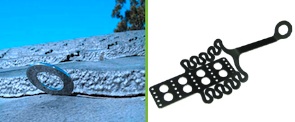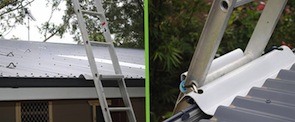Hierarchy of Control
The Hierarchy of Control is designed to control risks. The controls are ranked according to their effectiveness in controlling hazards at their source:
- Level 1: Undertake the work on the ground or on a solid construction
- Level 2: Undertake the work using a passive fall protection device
- Level 3: Undertake the work using a work positioning system
- Level 4: Undertake the work using a fall injury prevention system
- Level 5: Undertake the work from ladders or implement administrative controls
Level 1
Level 1 eliminates the hazard altogether. To achieve this, building owners could relocate plant and equipment away from fall hazards. In the case of roof work though, it is the roof we need to access - so it is not possible to eliminate risk altogether.
Level 2
If Level 1 is not practicable, Level 2 calls for a passive fall prevention device, such as a catwalk or walkway, to eliminate the hazard presented by the non-load-bearing material and guardrails on the side to prevent anyone from stepping off the walkway. Alternatively, an elevated platform (Or Cherry Picker, etc.) can be used to do roof work or to clean the gutters. This may not be able to be possible if it introduces other hazards, such as proximity to overhead power cables, or the cost makes it not practicable.
Level 3
Work positioning systems, such as roof anchor points or static lines, require a high level of user skill. They also demand ongoing involvement by the PCBU (controller/owner of the workplace) in the form of training, regulating access, risk assessments and consultation. Level 3 controls won't prevent a fall through fragile surfaces (Such as Asbestos roofs, laserlite, etc.), making them effectively Level 4 controls.
Level 4
Level 4 controls include fall arrest systems such as tested and annually certified roof anchor systems and static lines. The use of Level 4 controls acknowledges that injury is almost unavoidable in the event of a fall but aims to save lives. The workload associated with Level 4 controls is high. Apart from the ongoing responsibilities of training, etc. the controller of the workplace is responsible for emergency rescue procedures and medical evacuation.
Level 5
If Level 4 isn’t practical, then, as a last resort, Level 5 controls such as signage or training are used.
Contact Sydney Anchor Points Today
Looking for reliable roof safety solutions in Sydney? Sydney Anchor Points specialises in certified roof anchor point installations, ladder brackets, roof access hatches, and complete height safety systems for residential, commercial, and strata properties.
Our expert team services all of Sydney, from the CBD to Northern Beaches, Eastern Suburbs, Western Sydney, and beyond. With over 20 years of experience, we provide certified, industry-leading installations that comply with AS/NZS1891.4 standards, ensuring your property meets all workplace safety requirements.
Why choose us? We offer personalised service, competitive quotes, and annual reminders for system re-certifications. Backed by extensive qualifications and a strong reputation, we’re Sydney’s trusted name for roof safety.
Don’t compromise on safety. Call 02 8020 5777 or fill out our contact form today for a free quote and expert advice. Sydney Anchor Points – keeping Sydney safe, one roof at a time.




